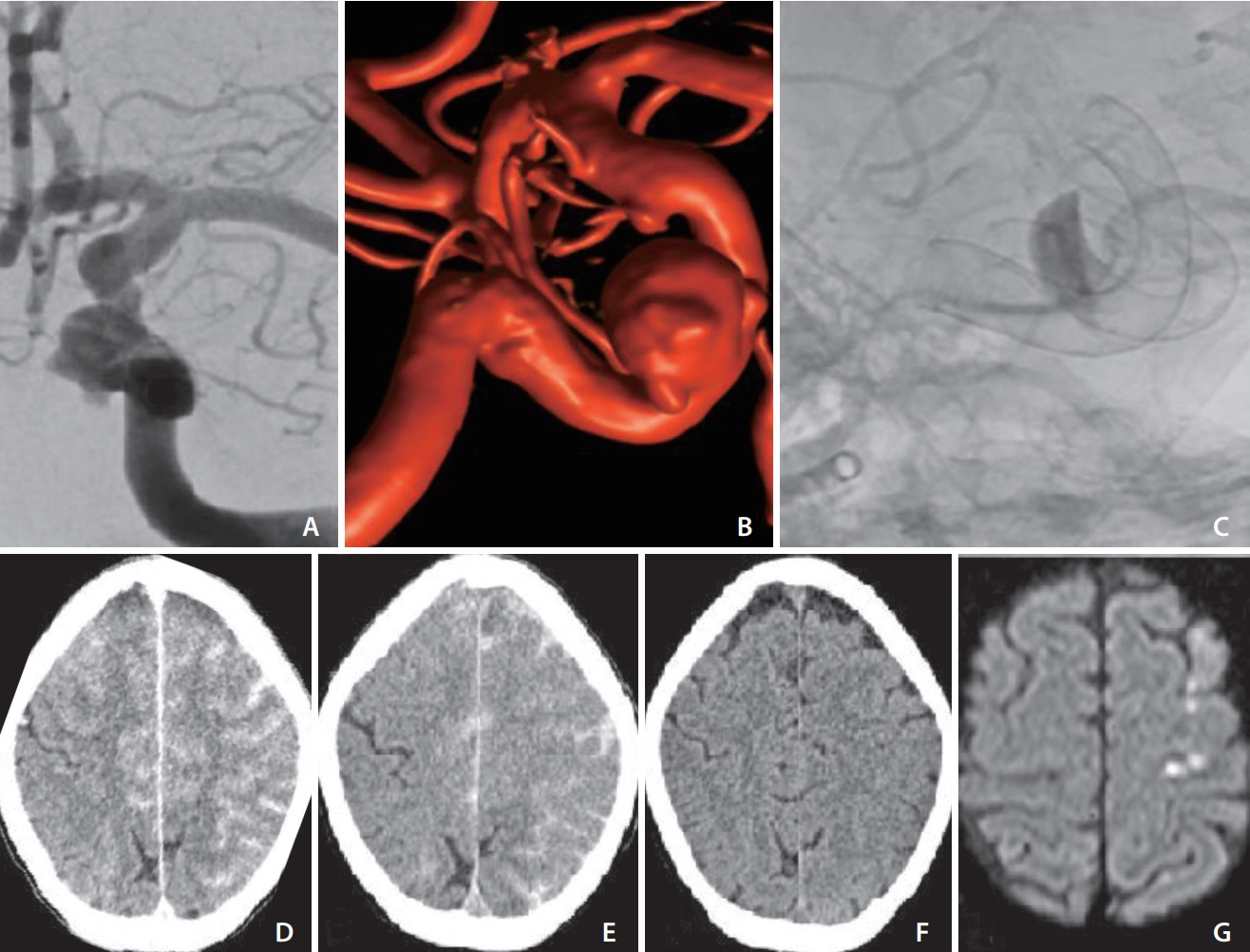Neurointervention.
2023 Mar;18(1):58-62. 10.5469/neuroint.2022.00353.
Fully Reversible Contrast-Induced Encephalopathy Mimicking Stroke after Flow Diverter Treatment of Carotid Cave Aneurysm
- Affiliations
-
- 1Department of Neuroradiology, Otto-von-Guericke University, Magdeburg, Germany
- 2Department of Neurosurgery, Otto-von-Guericke University, Magdeburg, Germany
- KMID: 2539947
- DOI: http://doi.org/10.5469/neuroint.2022.00353
Abstract
- Contrast-induced encephalopathy (CIE) is a rare complication of coronary and neurointerventional procedures. The condition is believed to arise from endothelial damage secondary to exposure to iodinated contrast media. A wide spectrum of clinical manifestations has been reported including seizures, cortical blindness, and focal neurological deficits. This report details the case of fully reversible CIE mimicking severe anterior circulation stroke in a 55-year-old female following elective endovascular treatment with a flow diverter of a carotid cave aneurysm. The patient was managed conservatively with intravenous hydration and steroids and showed an excellent prognosis with supportive management.
Keyword
Figure
Reference
-
1. Chu YT, Lee KP, Chen CH, Sung PS, Lin YH, Lee CW, et al. Contrast-induced encephalopathy after endovascular thrombectomy for acute ischemic stroke. Stroke. 2020; 51:3756–3759.
Article2. Potsi S, Chourmouzi D, Moumtzouoglou A, Nikiforaki A, Gkouvas K, Drevelegas A. Transient contrast encephalopathy after carotid angiography mimicking diffuse subarachnoid haemorrhage. Neurol Sci. 2012; 33:445–448.
Article3. Yu J, Dangas G. Commentary: new insights into the risk factors of contrast-induced encephalopathy. J Endovasc Ther. 2011; 18:545–546.
Article4. Leong S, Fanning NF. Persistent neurological deficit from iodinated contrast encephalopathy following intracranial aneurysm coiling. A case report and review of the literature. Interv Neuroradiol. 2012; 18:33–41.
Article5. Cristaldi PMF, Polistena A, Patassini M, de Laurentis C, Giussani C, Remida P. Contrast-induced encephalopathy and permanent neurological deficit: a case report and literature review. Surg Neurol Int. 2021; 12:273.
Article6. Lantos G. Cortical blindness due to osmotic disruption of the blood-brain barrier by angiographic contrast material: CT and MRI studies. Neurology. 1989; 39:567–571.
Article7. Uchiyama Y, Abe T, Hirohata M, Tanaka N, Kojima K, Nishimura H, et al. Blood brain-barrier disruption of nonionic iodinated contrast medium following coil embolization of a ruptured intracerebral aneurysm. AJNR Am J Neuroradiol 2004;25:1783-1786 Erratum in: AJNR Am J Neuroradiol. 2005; 26:203.8. Liu MR, Jiang H, Li XL, Yang P. Case report and literature review on low-osmolar, non-ionic iodine-based contrast-induced encephalopathy. Clin Interv Aging. 2020; 15:2277–2289.9. Iwata T, Mori T, Tajiri H, Miyazaki Y, Nakazaki M. Repeated injection of contrast medium inducing dysfunction of the bloodbrain barrier: case report. Neurol Med Chir (Tokyo). 2013; 53:34–36.
Article10. Vazquez S, Graifman G, Spirollari E, Ng C, Uddin A, Feldstein E, et al. Incidence and risk factors for acute transient contrast-induced neurologic deficit: a systematic review with meta-analysis. Stroke Vasc Interv Neurol. 2022; 2:e000142.
Article11. Kamimura T, Nakamori M, Imamura E, Hayashi Y, Matsushima H, Mizoue T, et al. Low-dose contrast-induced encephalopathy during diagnostic cerebral angiography. Intern Med. 2021; 60:629–633.
Article12. Eckel TS, Breiter SN, Monsein LH. Subarachnoid contrast enhancement after spinal angiography mimicking diffuse subarachnoid hemorrhage. AJR Am J Roentgenol. 1998; 170:503–505.
Article13. Spina R, Simon N, Markus R, Muller DW, Kathir K. Contrast-induced encephalopathy following cardiac catheterization. Catheter Cardiovasc Interv. 2017; 90:257–268.
Article14. Nagamine Y, Hayashi T, Kakehi Y, Yamane F, Ishihara S, Uchino A, et al. Contrast-induced encephalopathy after coil embolization of an unruptured internal carotid artery aneurysm. Intern Med. 2014; 53:2133–2138.
Article15. Zhao W, Zhang J, Song Y, Sun L, Zheng M, Yin H, et al. Irreversible fatal contrast-induced encephalopathy: a case report. BMC Neurol. 2019; 19:46.
Article16. Jang HW, Lee HJ. Posterior reversible leukoencephalopathy due to “triple H“ therapy. J Clin Neurosci. 2010; 17:1059–1061.
Article17. Giraldo EA, Fugate JE, Rabinstein AA, Lanzino G, Wijdicks EF. Posterior reversible encephalopathy syndrome associated with hemodynamic augmentation in aneurysmal subarachnoid hemorrhage. Neurocrit Care. 2011; 14:427–432.
Article18. Skolarus LE, Gemmete JJ, Braley T, Morgenstern LB, Pandey A. Abnormal white matter changes after cerebral aneurysm treatment with polyglycolic-polylactic acid coils. World Neurosurg. 2010; 74:640–644.
Article19. Allison C, Sharma V, Park J, Schirmer CM, Zand R. Contrast-induced encephalopathy after cerebral angiogram: a case series and review of literature. Case Rep Neurol. 2021; 13:405–413.
Article20. Lo LW, Chan HF, Ma KF, Cheng LF, Chan TK. Transient cortical blindness following vertebral angiography: a case report. Neurointervention. 2015; 10:39–42.
Article21. Meijer FJA, Steens SCA, Tuladhar AM, van Dijk ED, Boogaarts HD. Contrast-induced encephalopathy-neuroimaging findings and clinical relevance. Neuroradiology. 2022; 64:1265–1268.
Article22. Matsubara N, Izumi T, Miyachi S, Ota K, Wakabayashi T. Contrast-induced encephalopathy following embolization of intracranial aneurysms in hemodialysis patients. Neurol Med Chir (Tokyo). 2017; 57:641–648.
Article23. Niimi Y, Kupersmith MJ, Ahmad S, Song J, Berenstein A. Cortical blindness, transient and otherwise, associated with detachable coil embolization of intracranial aneurysms. AJNR Am J Neuroradiol. 2008; 29:603–607.
Article24. Andone S, Balasa R, Barcutean L, Bajko Z, Ion V, Motataianu A, et al. Contrast medium-induced encephalopathy after coronary angiography- case report. J Crit Care Med (Targu Mures). 2021; 7:145–149.
Article25. Shinoda J, Ajimi Y, Yamada M, Onozuka S. Cortical blindness during coil embolization of an unruptured intracranial aneurysm--case report. Neurol Med Chir (Tokyo). 2004; 44:416–419.
Article
- Full Text Links
- Actions
-
Cited
- CITED
-
- Close
- Share
- Similar articles
-
- Symptomatic Post Endarterectomy Common Carotid Artery Pseudoaneurysm Treated with Combination of Flow Diverter Implantation and Carotid Stenting
- Kinking of Flow Diverter in a Giant Wide-Necked Supraclinoid Internal Carotid Artery Aneurysm
- Fracture of a Flow Diverter in the Cervical Internal Carotid Artery Due to Eagle Syndrome
- Clipping of a persistent middle cerebral artery aneurysm after previous flow diverter placement: An illustrative case and review of the literature
- Flow Diverter Device for Treatment of Cerebral Aneurysm with Short-Term Follow Up: Two Case Reports


